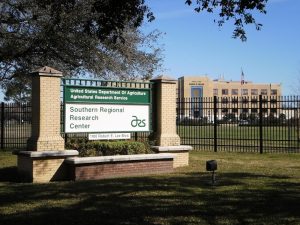A Cornucopia, Through Research
 To follow is an article from our current newsletter, The Humanist Advocate (Issue 1, 2017)
To follow is an article from our current newsletter, The Humanist Advocate (Issue 1, 2017)
October 15
A research director with the U. S. Department of Agriculture brought a large, open-mouth shopping bag with him for his presentation to our October meeting. In the bag were many of the products the Agricultural Research Service (ARS), a branch of the USDA is credited with developing.
The director, K. Thomas Klasson, Ph.D, has been known to the regulars and some occasional guests of NOSHA meetings as the husband of NOSHA President Charlotte Klasson. He broke the speaker-audience ice by quipping that although many knew him as such, he corrected it to “Dr. Charlotte’s Husband”. His educational background is deep with a Masters Degree from the Royal Institute of Technology in Stockholm and a doctorate from the University of Arkansas.
***
He worked for both UA and the Oak Ridge National Laboratory before joining USDA in 2004. His contributions to research papers are extensive.. His subtle and wry sense of humor emerged frequently throughout the presentation, and complimented the reserved and soft-spoken polite manner common in those with a Swedish heritage. He solved the problem of a cumbersome microphone by tying it to what looked like a piece of thick yarn and looped it around his neck. Before he began pulling examples from the shopping bag, he presented his shirt sleeve to a lady in the audience.
“Check out the shirt. See that nice crease right here? Pretty nice? It’s wrinkle-free cotton. This was invented right here in New Orleans!” The fabric, also know as permanent press, was created by the ARS which added a chemical to cotton that binds the molecules of the fiber so that once ironed,
they stayed in place.
Back to the bag: one by one, Klasson gave a short background narrative on each of the familiar and ubiquitous products he pulled from the bag (after the obligatory disclaimer of endorsement for the commercially branded articles), including: a vial of penicillin, a spray can of insect repellent, a can of tomato sauce, baby formula, a box of butter, a loaf of sourdough bread, a bunch of red, seedless grapes, a potato, blueberries, a can of frozen orange juice, a box of instantmashed potatoes. All these, and more, are pictured and explained in a colorful booklet published by the USDA entitled Science in
Your Shopping Cart; and all courtesy of your hard-working tax dollars at the ARS; and some, like the perma-press fabric, coming from right here at the Southern Regional Research Center campus of the USDA located on federal land in City Park.
The New Orleans location is one of four regional centers in the U. S. and is home to 50 scientists (Ph.D.s and post-docs) and 100 employees, and has an annual budget of 21 million dollars. The complex also houses the local offices FEMA and the Louisiana Department of Agriculture and Forestry. The USDA currently has about 750 ongoing projects; the ones that our local ARS is involved with fall into one of six major categories: Cotton Structure and Quality; Cotton Fiber Bioscience; Cotton Chemistry and Utilization; Commodity Utilization (which Klasson heads up); Food and Feed Safety; and Food Processing and Sensory Quality. The ARS is considered the “in house” research branch of the USDA because some of its research is done by “external” entities such as universities through grants and contracts.
Those research headings may sound like wordy bureaucratese, but from those or similar projects they have developed a process for freezing orange juice for worldwide distribution; bred the Roma tomato, which seems to be the only tomato that remains tasty throughout the year and is used exclusively in tomato paste; and invented a healthier cooking oil by a crystallization of cotton seed oil (hence the acronym “Crisco”). That single-serve cup of fresh fruit great for brown bag lunches or anytime snacks? Kept fresh longer by adding a calcium salt and vitamin C. In 1935, Dupont Corporation came up with an advertising slogan that ran, with modifications, for almost 50 years. We have all heard it: “Better Things for Better Living…Through Chemistry”.
It could well have been adopted by the USDA and its Agricultural Research Service.
